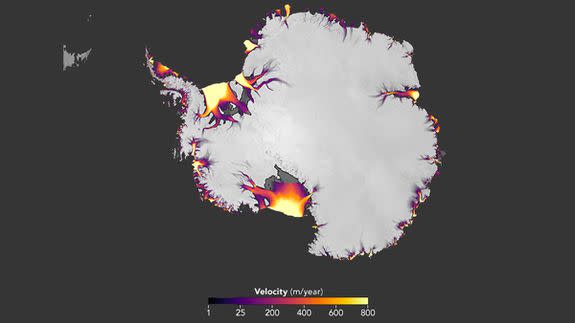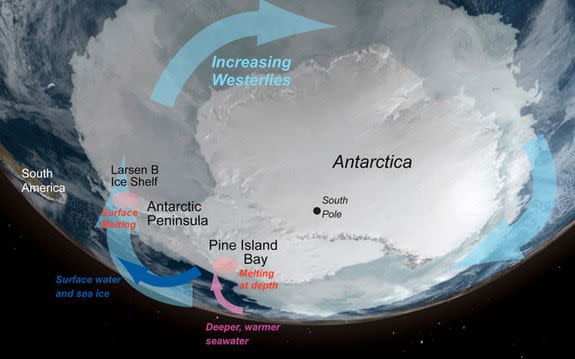Antarctica’s once sleepy ice sheets have awoken. That's bad.

Antarctica — home to the greatest ice sheets on Earth — isn't just melting significantly faster than it was decades ago. Great masses of ice that scientists once presumed were largely immune to melting are losing ample ice into the sea.
In a study published Monday in the journal Proceedings of the National Academy of Sciences, researchers illustrate that the ice-clad continent is losing more than six times as much ice as it was in the 1980s. A "major contributor," the scientists emphasize, are the glaciers in East Antarctica, a place long overshadowed by the rapidly melting glaciers of West Antarctica. They found East Antarctica has contributed about 20 percent of the melting in the last 10 years — which is no small amount.
"People are beginning to recognize that East Antarctica might be waking up," Josh Willis, an oceanographer at NASA's Jet Propulsion Laboratory that visits and measures Earth's melting glaciers, said in an interview.
"There’s growing evidence that eastern Antarctica is not just going to stay frozen and well-behaved in the next 50 to 100 years," Willis, who had no role in the study, said.
This builds on other recent, emerging evidence that East Antartica is destabilizing as it sheds more ice into the sea.

Image: nasa
Overall, Antarctica is now losing tremendous, nearly unimaginable quantities of ice into the ocean each year — the brunt of which still comes from West Antartica. Using satellite data to measure how much snow is accumulating on the land versus how much is flowing away, the researchers found Antarctica lost 40 gigatons of ice in the 1980s. For reference, a single gigaton is equivalent to 1 billion metric tons — and there are about 2,200 pounds in a single metric ton.
But fast forward to the last decade, and Antarctica lost around 252 gigatons of ice, or over 2.5 trillion metric tons, between 2009 and 2017, according to this most recent study.
These numbers may be massive, but they're "in line with" equally profound ice loss numbers that came out last year, noted Stef Lhermitte, a geoscientist at the Netherlands' Delft University of Technology who had no role in the study, said over email. That grand research project — put together by 40 Earth sciences agencies including NASA, the European Space Agency, and the National Snow and Ice Data Center — found Antarctica had shed nearly 3 trillion tons of ice over the last 25 years.
SEE ALSO: 2018 takes the podium as one of the hottest years on record. Let’s look deeper.
Unlike the Arctic glaciers — like those in rapidly melting Greenland — Antarctica isn't melting everywhere. It's largely happening at the coast, where the continent's great glaciers float over the ocean (these are called ice shelves). The problem is, as the planet warms wind patterns are changing around Antarctica. And these winds, called the polar westerlies, are now pushing warmer waters into Antarctica's glaciers.
"It touches these glaciers," said Willis. "Some of these glaciers are really balanced on a precipice — all you need is a little bit of warm water and all of a sudden it's off to the races."
The consequences are easy to see.
Manhattan-sized chunks of ice have repeatedly broken from West Antarctica's Pine Island Glacier over the last decade, as warm waters eat away at the glaciers from below.
"We have seen this weakening reflected in the frequent calving of Pine Island Glacier and the retreat of its calving front during the last years," said Lhermitte, who uses satellites to keep vigilant track of the cracking and rupturing Antarctic glaciers.

Image: NASA/NSIDC
The big, looming question, though, is how fast the western and eastern Antarctic glaciers will melt in the future, and what that portends for sea level rise. Already, the accelerating trends have attracted profound interest, and concern, from scientists.
"The increased [melting] rate is what drives much of our work in the polar regions," Robin Bell, a geophysicist at Columbia University's Lamont-Doherty Earth Observatory who specializing in Antarctica's changing ice sheets, said over email. Bell had no involvement in the study.
For the majority of us living thousands of miles from Antarctica, the messages from this behemoth land — which contains enough ice to raise sea levels by 58 meters, is a little confusing. On one hand, the ice loss numbers are unquestionably big, notes Bell, but when it comes to sea level rise numbers, things can appear "sort of small," she said. Since 1979, Antartica is believed to have added about 14 millimeters — a little over half an inch — to the planet's total sea level rise.
But, there's no evidence the melting is going to stop. As this most recent research shows, we should expect the melt to keep accelerating, which brings giant implications to planet's billions of coastal dwellers. Combined with the melting of glaciers on Greenland and those vanishing on Earth's mountains, this could mean two to three feet of sea level rise by the century's end — or possibly even six feet.
"I think this study shows again that, while Antarctica is the largest uncertainty in current projections of sea level rise, it is losing mass rapidly, close to the upper range of projections," said Lhermitte. "Since these changes could have far-reaching implications, it shows again that we should further focus on better understanding the response of Antarctica in a changing climate."
At worst, scientists fear that Antarctic ice shelves — which act as a plug holding back the continent's gargantuan ice sheets, may hit a breaking point. Specifically, these floating glaciers may recede so much that they're no longer grounded to the seafloor. This could "pull the plug," with nothing left to hold back the continent's ice. It will flow into the sea, unimpeded.
And as this new research shows, it's not just melting in Western Antarctica that scientists have to worry about now. East Antartica is starting to throw its weight around, too.
"It's another reminder that the biggest ice sheet on the planet is over the South Pole — and it's bigger and scarier than we thought," said Willis. "Because there’s a whole new sector that we have to worry about now."
WATCH: Virgin Galactic reaches the edge of space


